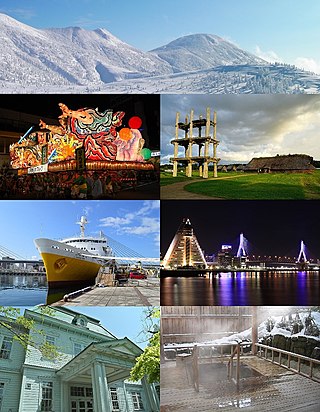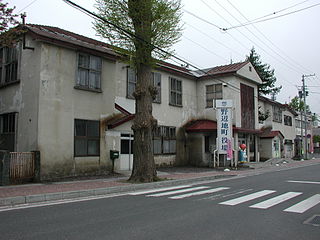
Aomori, officially Aomori City, is the capital city of Aomori Prefecture, in the Tōhoku region of Japan. As of 1 August 2023, the city had an estimated population of 264,945 in 136,781 households, and a population density of 321 people per square kilometer spread over the city's total area of 824.61 km2 (318.38 sq mi). Aomori is one of Japan's 62 core cities and the core of the Aomori metropolitan area.

Aomori Prefecture ([a̠o̞mo̞ɾʲikẽ̞ɴ]) is a prefecture of Japan in the Tōhoku region. The prefecture's capital, largest city, and namesake is the city of Aomori. Aomori is the northernmost prefecture on Japan's main island, Honshu, and is bordered by the Pacific Ocean to the east, Iwate Prefecture to the southeast, Akita Prefecture to the southwest, the Sea of Japan to the west, and Hokkaido across the Tsugaru Strait to the north. Aomori Prefecture is the 8th-largest prefecture, with an area of 9,645.64 km2 (3,724.20 sq mi), and the 31st-most populous prefecture, with more than 1.18 million people. Approximately 45 percent of Aomori Prefecture's residents live in its two core cities, Aomori and Hachinohe, which lie on coastal plains. The majority of the prefecture is covered in forested mountain ranges, with population centers occupying valleys and plains. Aomori is the third-most populous prefecture in the Tōhoku region, after Miyagi Prefecture and Fukushima Prefecture. Mount Iwaki, an active stratovolcano, is the prefecture's highest point, at almost 1,624.7 m (5,330 ft).

Misawa Air Base is an air base of the Japan Air Self-Defense Force (JASDF), the United States Air Force, and the United States Navy located in Misawa, Aomori, in the northern part of the island of Honshū of Japan. It is located 3 NM northeast of Misawa railway station, 4.8 km (3.0 mi) west of the Pacific Ocean, 16 km (9.9 mi) northeast of Towada, 29 km (18 mi) northwest of Hachinohe, and 684 km (425 mi) north of Tokyo at the "Tip of the Spear". It is a Pacific Air Forces (PACAF) facility with the 35th Fighter Wing as its host wing. It hosts both Japanese and American troops.

Hirosaki is a city located in western Aomori Prefecture, Japan. As of 1 February 2023, the city had an estimated population of 163,639 in 71,044 households, and a population density of 310 per square kilometre (800/sq mi). The total area of the city is 524.20 square kilometers (202.39 sq mi).

Hachinohe is a city located in Aomori Prefecture, Japan. As of 1 August 2023, the city had an estimated population of 216,416 in 110,195 households, and a population density of 708 persons per km2, making it Aomori Prefecture's second largest city by population. The city has a total area of 305.56 square kilometres (117.98 sq mi).

Kuroishi is a city located in Aomori Prefecture, Japan. As of 31 January 2023, the city had an estimated population of 31,540 in 13,948 households and a population density of 150 persons per km2. The total area of the city is 217.05 square kilometers (83.80 sq mi).

Towada is a city in Aomori Prefecture, Japan. As of 31 January 2023, the city had an estimated population of 58,905 in 28031 households, and a population density of 81 persons per km2 The total area of the city is 725.65 square kilometers (280.18 sq mi).Towada is home to the national and prefectural agencies that administer the Kamikita region, and is the central city of the region. In October 2012, the city signed an agreement with nine surrounding municipalities to improve the living environment, and has a cooperative relationship with Misawa City, which has an airport and a U.S. Air Force base.

Ninohe is a city located in Iwate Prefecture, Japan. As of 31 March 2020, the city had an estimated population of 26,344, and a population density of 63 persons per km2 in 11,803 households. The total area of the city is 420.42 square kilometres (162.33 sq mi).

Shingō is a village located in Aomori Prefecture, Japan. As of 28 February 2023, the village has an estimated population of 2,192 in 895 households and a population density of 15 persons per km2. The total area of the village is 150.77 square kilometres (58.21 sq mi).

Hiranai is a town located in Aomori Prefecture, Japan and a part of the Aomori metropolitan area. As of 1 December 2023, the town had an estimated population of 9,967 in 4,775 households, and a population density of 46 persons per km². It is the most heavily populated town in Higashitsugaru District. The total area of the town is 217.09 km2 (83.82 sq mi).

Noheji is a town located in Aomori Prefecture, Japan. As of 28 February 2023, the town had an estimated population of 12,249 in 6313 households, and a population density of 150 persons per km2. The total area of the town is 81.68 square kilometers (31.54 sq mi).

Rokunohe is a town located in Aomori Prefecture, Japan. As of 31 January 2023, the town had an estimated population of 10,812 in 4645 households, and a population density of 130 persons per km2. The total area of the town is 83.89 square kilometres (32.39 sq mi)

Tōhoku is a town located in Aomori Prefecture, Japan. As of 31 December 2022, the town had an estimated population of 16,625 in 7251 households, and a population density of 51 persons per km² in 7,269 households. The total area of the town is 326.50 km2 (126.06 sq mi).

Rokkasho is a village in Aomori Prefecture, Japan. As of 1 March 2023, the village had an estimated population of 9,845 in 4988 households, and a population density of 40 persons per km². The total area of the village is 252.68 square kilometres (97.56 sq mi).

Kamikita District is a district located in Aomori Prefecture, Japan. It occupies the east-central portion of the prefecture, south of Shimokita Peninsula.

Sannohe is a town located in Aomori Prefecture, Japan. As of 31 January 2023, the town had an estimated population of 9,146 in 4141 households, and a population density of 60 persons per km2. The total area of the town is 151.79 square kilometres (58.61 sq mi).

Gonohe is a town located in Aomori Prefecture, Japan. As of 1 March 2023, the town had an estimated population of 16,013 in 7027 households, and a population density of 90 persons per km2. The total area of the town is 177.67 square kilometres (68.60 sq mi).

Nanbu is a town located in Aomori Prefecture, Japan. As of 1 March 2023, the town had an estimated population of 16,885 in 7466 households, and a population density of 110 persons per km2. The total area of the town is 153.12 square kilometres (59.12 sq mi).

Oirase is a town located in Aomori Prefecture, Japan. As of 31 January 2023, the town had an estimated population of 25,225 in 10789 households, and a population density of 350 persons per km². The total area of the town is 71.96 square kilometres (27.78 sq mi).

Lake Ogawara is Japan's eleventh largest lake and the largest in Aomori Prefecture. It spans the boundaries of the city of Misawa, the town of Tōhoku, and the village of Rokkasho in Kamikita District.

























